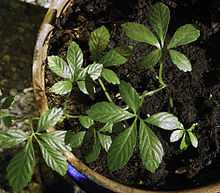Gynostemma
| Gynostemma | |
|---|---|
 | |
| Gynostemma pentaphyllum growing in potting soil | |
| Scientific classification | |
| Kingdom: | Plantae |
| (unranked): | Angiosperms |
| (unranked): | Eudicots |
| (unranked): | Rosids |
| Order: | Cucurbitales |
| Family: | Cucurbitaceae |
| Genus: | Gynostemma Blume[1] |
| Species | |
|
See text | |
Gynostemma is a genus of perennial climbing vines in the cucumber, gourd, and melon family, comprising at least 19 species, all native to the tropical East or Far East, inclusive of the Himalayas: China (with 9 endemic); the islands of Japan; Malaysia; and New Guinea.[2] The prefix Gyno- is from Greek, meaning "woman", "female"; the suffix -stemma is New Latin, from Greek meaning "wreath" or "garland". German-Dutch botanist Carl Ludwig Blume described Gynostemma from two species he named:[3] G. pedata (later changed, to pedatum)[4] and G. simplicifolia (also later changed, to simplicifolium).[5] Neither species was clearly designated by him as the type; however, the former species, G. pedatum is now considered to be a synonym of G. pentaphyllum (Thunb.) Makino.[6] The genus was published in 1825, in Bijdragen tot de flora van Nederlandsch Indië ("Contributions to the flora of Netherlands India").[1][3]
General description
All species of Gynostemma have tendrils (usually branching); most are dioecious. The leaves are usually in palmately arrayed leaflets (3–9, ovate-lanceolate in shape), arranged alternately on the stem; a few species are leaved, but without leaflets. Inflorescences are either racemose or paniculate. Fruits can be capsular or pea-like, containing two or three seeds.[2]
Selected species
- G. aggregatum C.Y.Wu & S.K.Chen
- G. burmanicum King ex Chakrav.
- G. cardiospermum Cogn. ex Oliv.
- G. caulopterum S.Z.He
- G. compressum X.X.Chen & D.R.Liang
- G. guangxiense X.X.Chen & D.H.Qin
- G. intermedium W.J.de Wilde & Duyfjes
- G. laxiflorum C.Y.Wu & S.K.Chen
- G. laxum (Wall.) Cogn.
- G. longipes C.Y.Wu
- G. microspermum C.Y.Wu & S.K.Chen
- G. pallidinerve Z.Zhang
- G. papuanum W.J.de Wilde & Duyfjes
- G. pentagynum Z.P.Wang
- G. pentaphyllum (Thunb.) Makino
- G. pubescens (Gagnep.) C.Y.Wu
- G. simplicifolium Blume
- G. yixingense (Z.P.Wang & Q.Z.Xie) C.Y.Wu & S.K.Chen
- G. zhejiangense X.J.Xue
- List source :[7]
References
- ↑ 1.0 1.1 Gynostemma was originally described and published in Bijdragen tot de flora van Nederlandsch Indië 23. 1825. "Name - !Gynostemma Blume". Tropicos. Saint Louis, Missouri: Missouri Botanical Garden. Retrieved December 1, 2012.
- ↑ 2.0 2.1 Shukun Chen & Charles Jeffrey; Enkylia Griffith; Pestalozzia Zollinger & Moritzi; Trirostellum Z. P. Wang & Q. Z. Xie. "Gynostemma". Flora of China (eFloras) 19. Retrieved December 1, 2012.
- ↑ 3.0 3.1 Original text by Carl Ludwig von Blume (1825). Bijdragen tot de flora van Nederlandsch Indië. p. 23. Retrieved December 1, 2012.
- ↑ "Name - Gynostemma pedatum Blume". Tropicos. Retrieved December 1, 2012.
- ↑ "Name - !Gynostemma simplicifolium Blume". Tropicos. Retrieved December 1, 2012.
- ↑ "TPL, treatment of Gynostemma pedatum". The Plant List; Version 1. (published on the internet). Royal Botanic Gardens, Kew and Missouri Botanical Garden. 2010. Retrieved December 1, 2012.
- ↑ "TPL, treatment of Gynostemma". Retrieved December 1, 2012.